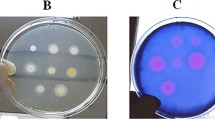Abstract
Streptococcus species is considered as an important pathogen for human and animals. The antibiotic resistance mechanism in this species is continuously increased. On the other side, the tolerance of environmental stresses play an effective role in the severity of many streptococcal causative disease. In this study we assayed survey on the causative agents of pharyngitis and tonsillitis patients. The predominant causative strain was Streptococcus pyogenes with 93 % isolating ratio frequency. The other pathogenic species were S. agalactia 5.3 % and S. pneumonia 1.7 %. According to the antibiotic resistant test the S. pyogenes isolates were classified into six different groups. A selected strain from each antibiotic resistant group was tested for tolerance of a restrictive environmental factors. The variations of the environmental niches of isolates were in consistence with their antibiotic resistant variation.

Similar content being viewed by others
References
Cunningham MW (2000) Pathogenesis of group A streptococcal infections. Clin Microbiol Rev 13:470–511
Russo FD, Silhavy TJ (1993) The essential tension: opposed reactions in bacterial two-component regulatory systems. Trends Microbiol 1:306–310
Hoch JA (2000) Two-component and phosphorelay signal transduction. Curr Opin Microbiol 3:165–170
Tracy DL, Scott JR (2004) CovS inactivates CovR and is required for growth under conditions of general stress in Streptococcus pyogenes. J Bacteriol 186(12):3928–3937
Nelson K, Schlievert PM, Selander RK, Musser JM (1991) Characterization and clonal distribution of four alleles of the speA gene encoding pyrogenic exotoxin A (scarlet fever toxin) in Streptococcus pyogenes. J Exp Med 174:1271–1274
Musser JM, Krause RM (1998) The revival of group A streptococcal diseases, with a commentary on staphylococcal toxic shock syndrome. In: Krause RM (ed) Emerging infections. Academic Press, New York, pp 185–218
Schuchat A (2001) Group B streptococcal disease: from trials and tribulations to triumph and trepidation. Clin Infect Dis 33:751–756
Bisno AL, Gerber MA, Gwaltney JM Jr, Kaplan EL, Schwartz RH (2002) Practice guidelines for the diagnosis and management of group A streptococcal pharyngitis. Clin Infect Dis 35:113–125
Ruoff KL, Whiley RA, Beighton D (2003) Streptococcus. In: Murray PR, Baron EJ, Jorgensen JH, Pfaller MA, Yolken RH (eds) Manual of clinical microbiology, 8th edn. American Society for Microbiology, Washington, pp 405–421
Traub WH, Leonhard B (1997) Comparative susceptibility of clinical group A, B, C, F, and G β-hemolytic streptococcal isolates to 24 antimicrobial drugs. Chemotherapy 43:10–20
Gordon KA, Beach ML, Biedenbach DJ, Jones RN, Rhomberg PR, Mutnick AH (2002) Antimicrobial susceptibility patterns of β-hemolytic and viridans group streptococci: report from the SENTRY antimicrobial surveillance program (1997–2000). Diagn Microbiol Infect Dis 43:157–162
Biedenbach DJ, Stephen JM, Jones RN (2003) Antimicrobial susceptibility profile among β-haemolytic Streptococcus spp. collected in the SENTRY antimicrobial surveillance program-North America (2001). Diagn Microbiol Infect Dis 46:291–294
Bergey’s (1983) Manual of systematic bacteriology, 8th edn. William and Wilkins, Co, Baltimor
Silverstein RM (1975) The determination of human plasminogen using Nα–CBZ-l-lysine p-nitrophenyl ester as substrate. Anal Biochem 65:500–506
Bauer AW, Kirby WMM, Sherris JC, Turck M (1966) Antibiotic susceptibility testing by a standardized single disc method. Am J Pathology 49:493–496
Kim HY, Uh Y (2004) Macrolide resistance in β-hemolytic streptococci: changes after the implementation of the separation of prescribing and dispensing of medications policy in Korea. Yonsei Med J 45:591–597
Brahmadathan KN, Anitha P, Gladstone P (2005) Increasing erythromycin resistance among group A streptococci causing tonsillitis in a tertiary care hospital in southern India. Clin Microbiol Infect 11:335–337
Baldassarri L, Creti R, Recchia S, Imperi M, Facinelli B, Giovanetti E, Pataracchia M, Alfarone G, Orefici G (2006) Therapeutic failures of antibiotics used to treat macrolide-susceptible Streptococcus pyogenes infections may be due to biofilm formation. J Clin Microbiol 44(8):2721–2727
Sato T, Tateda K, Kimura S, Iwata M, Ishii Y, Yamaguchi K (2011) In vitro antibacterial activity of modithromycin, a novel 6,11-bridged bicyclolide, against respiratory pathogens, including macrolide-resistant gram-positive cocci. Antimicrob Agents Chemother 55(4):1588–1593
Uh Y, Yong D, Lee K, Kwon O, Yoon KJ (2005) Emergence of erythromycin-resistant Streptococcus agalactiae serotype V is due to clonal spread. Korean J Lab Med 25:564
Uh Y, Hwang GY (2007) In: Jang H, Cho HM, Noh SM, Kim HY, Kwon O, Yoon KJ (eds) Macrolide resistance trends in β-hemolytic streptococci in a tertiary Korean hospital. Yonsei Med J 48(5): 773–778. doi:10.3349/ymj.2007.48.5.773
Bacciaglia A, Brenciani A, Varaldo PE, Giovanetti E (2007) SmaI type ability and tetracycline susceptibility and resistance in Streptococcus pyogenes isolates with efflux-mediated erythromycin resistance. Antimicrob Agents Chemother 51(8):3042–3043
Chaussee MS, Ajdic D, Ferretti JJ (1999) The rgg gene of Streptococcus pyogenes NZ131 positively influences extracellular SPE B production. Infect Immun 67:1715–1722
Chaussee MS, Watson RO, Smoot JC, Musser JM (2001) Identification of Rgg-regulated exoproteins of Streptococcus pyogenes. Infect Immun 69:822–831
Chaussee MS, Somerville GA, Reitzer L, Musser JM (2003) Rgg coordinates virulence factor synthesis and metabolism in Streptococcus pyogenes. J Bacteriol 185:6016–6024
Smoot LM, Smoot JC, Graham MR, Somerville GA, Sturdevant DE, Lux Migliaccio CA, Sylva GL, Musser JM (2001) Global differential gene expression in response to growth temperature alteration in group A streptococcus. PNAS 98(18):10416–10421
Author information
Authors and Affiliations
Corresponding author
Rights and permissions
About this article
Cite this article
Abbas, N., Ismail, M. & El-Shahat Ebeid, M. Response of Different Antibiotic Resistant Group of Streptococcus pyogenes to Environmental Stresses. Indian J Microbiol 52, 354–359 (2012). https://doi.org/10.1007/s12088-012-0273-z
Received:
Accepted:
Published:
Issue Date:
DOI: https://doi.org/10.1007/s12088-012-0273-z




